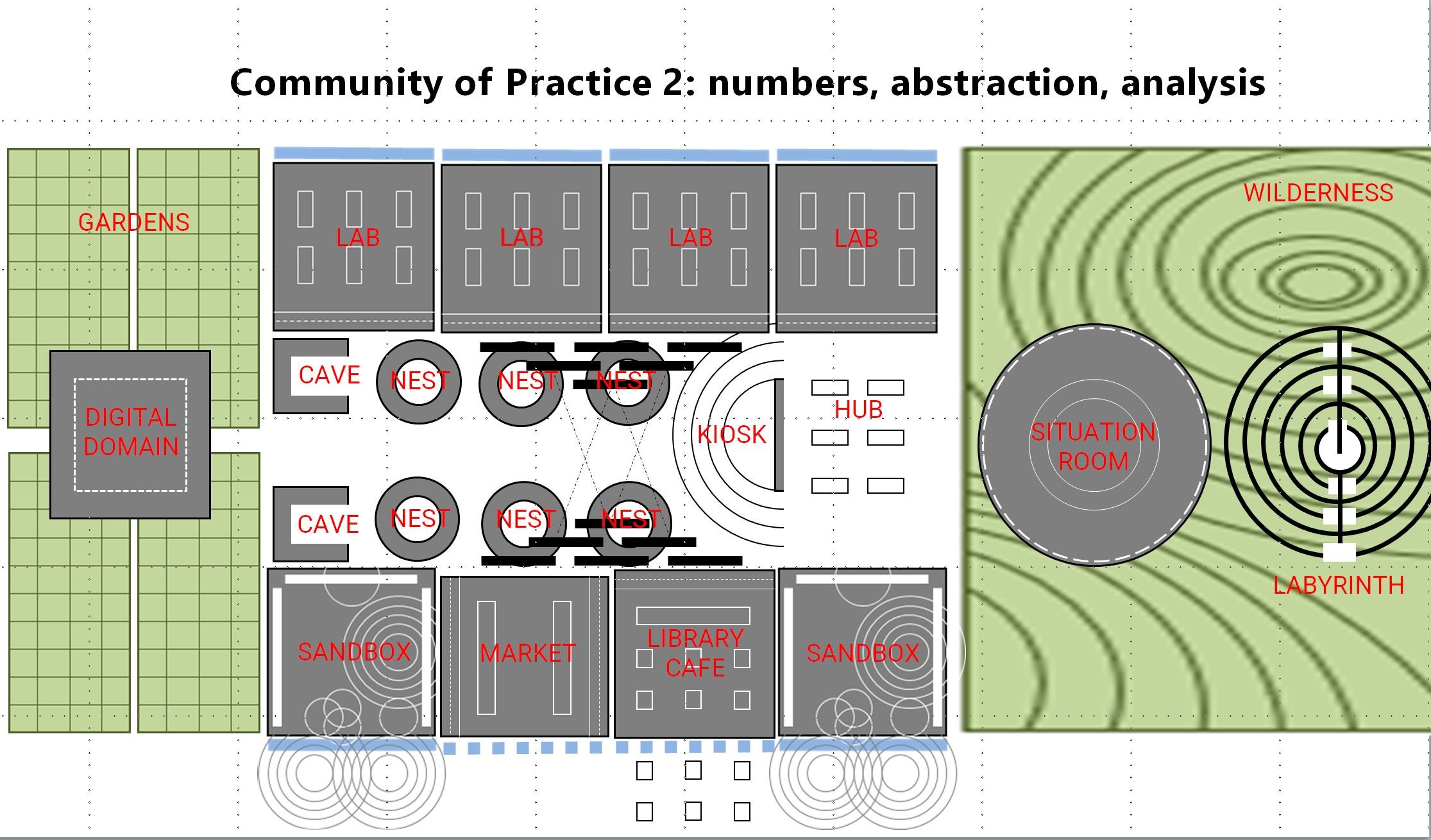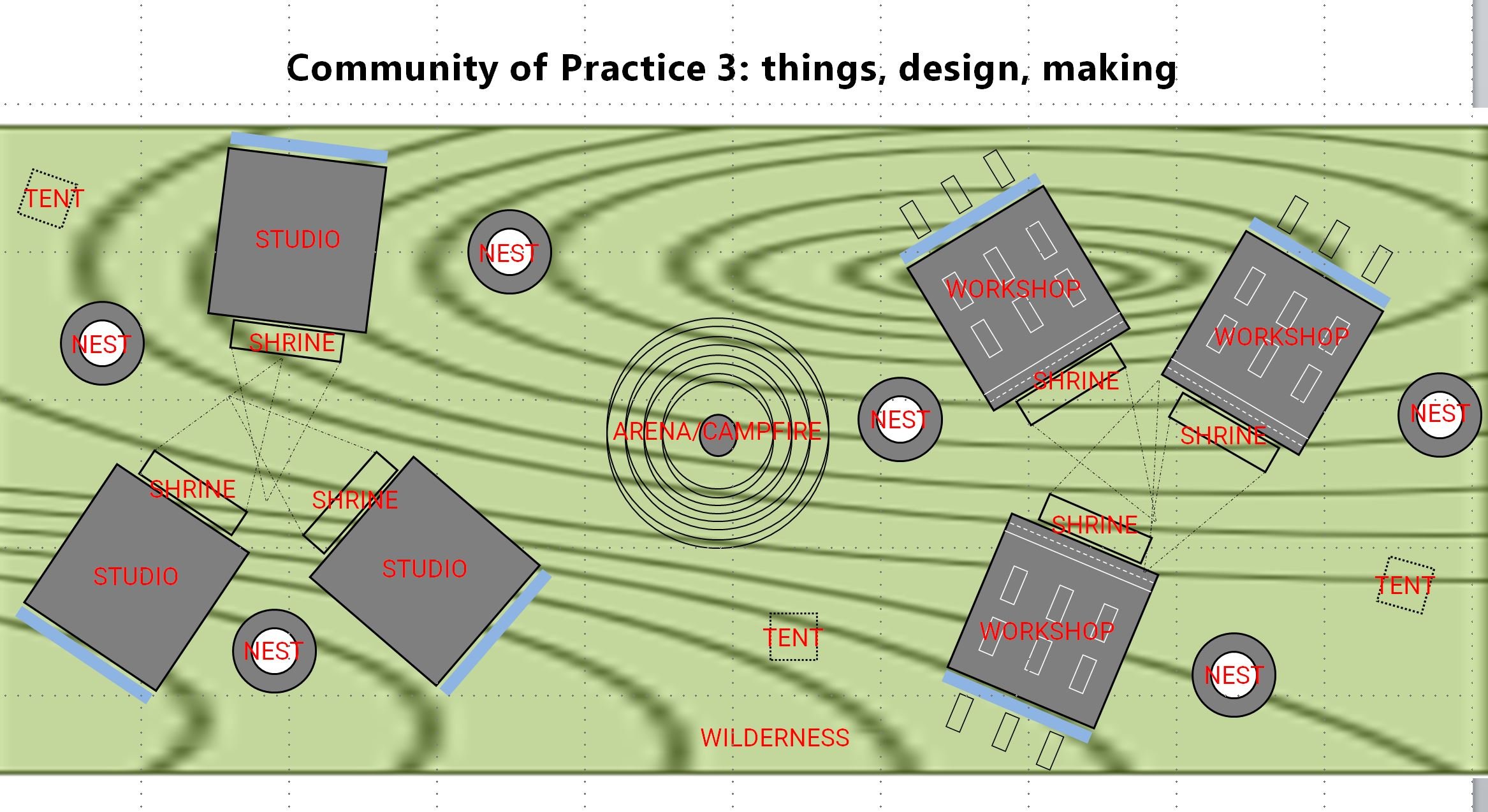Workshop Exercise
I presented the ideas in this book and blog to the Learningscapes 2021 conference in Denver, Colorado on Saturday, October 16, 2021 and to a small study group in advance of the conference. After explaining the concepts of Professional Learning Communities and Educational Ecosystems, I gave each group stickers with the full array of educational environments and asked them to imagine a PLC. Here are some of the results from those exercises, labelled and cleaned up graphically afterwards for clarity:
I like the central hub with the attention to the privacy of the teachers housed there, and I like the surrounding inspiration zone. That zone might have been more powerful still had the Market not obstructed access to the outdoors towards the right. Had it been located to the left of the library, then the cruciform plan would have viscerally connected the hub to the outdoors in every direction.
I also think this approach could have exploited the outdoors more fully instead of just creating a kind of courtyard. However, in an urban setting, this might be exactly right.
The choice of environments appropriately focused on storytelling, media, language learning, rhetoric and collaborative work. The lack of Wilderness is curious however, since I imagine it to be a rich resource for creativity. This scheme omits a Labyrinth, a way to process creative thought, making me wonder if creativity still struggles for a place in school. Is there a bias towards leaving creativity to the work done out of school?
Fascinating that a scheme devoted to finding order and pattern in the world holds rigidly to a grid, that it was conceived as a bridge between Wilderness to Garden (chaos to order perhaps?) and also that it found inspiration in the Labyrinth.
The Zone of Inspiration seems quite rich, though I expected to find Shrines for communicating the depth and breadth of mathematical and scientific thinking.
The focus on individual and small group work (Nests and Caves) suggests a tilt towards introspection and introversion, perhaps very appropriate to activities focused on puzzles.
Finally, the reliance on a digital domain, situation room, and digital arrays suggests a very computer oriented perspective. I wonder sometimes if the very abstractness of the subject matter wouldn’t benefit more from less abstract, more physical presentations, and hope to explore that more in future workshops.
I appreciate this scheme so much, because it challenges the premise that teachers should be housed in Hubs. This scheme adamantly keeps teachers in their studios and workshops, but mediates the experience with tents and nests scattered in the wilderness.
I appreciate as well how each studio pairs with a Shrine to display their work or their inspirations.
I also appreciate the commitment to Wilderness as the canvas for occupation, with the settlement centered on the Campfire. The entire scheme has the tentative and provisional character of a campground, and I imagine the experience of it would be indelible and engaging.
Engaging experience: this after all is the ultimate goal.
I appreciate the exchange between order and disorder in those dancing Caves, a quality I appreciate in music as well. That here too the scheme mediates between garden and wilderness (order and disorder again) reinforces the idea.
I had always imagined that a Market would be integral to a Library/Cafe, but this scheme challenges that preconception. I look forward to testing the issue further in the future.
I wonder if the teachers in this Hub would feel too disconnected from nature in this scheme, something that would no doubt have been considered in the iterative design process. This highlights the fact that all of these schemes are done quickly, in the moment, and without the normal level of programming, scrutiny and consideration. Nonetheless, I am impressed with the ideas and possibilities that are brought forward in the exercise. The actual point of the effort is not to necessarily generate a product, but to encourage participants to think differently about the school environment.
Here the teacher’s Hub is not centralized, and the context is imagined entirely as a Big Map. It feels so appropriate to the focus of this community of practice. I appreciate the centrality of the Campfire and presumably storytelling, as well as the Tents positioned outside of the enclave. Trekking out to those tents might just feel like an expedition.
This scheme foregoes traditional classrooms entirely in favor of Sandboxes, and that is of course where schools are going generally: to a model of 21st Century classrooms with multiple teaching walls, a reliance on technology to deliver content and experience, and access to the outdoors. I only wonder about such heavy reliance on this one typology, when so many other environments were possible. A Kiosk would have brought some of the content out into the open instead of keeping it behind classroom walls. A Situation Room might have offered powerful access to multiple, dynamic perspectives. A Media Booth might have offered students access to students and travelers all over the world. A Media Array might have brought far-off places and experiences into the experience of students taught here.
What I do appreciate is that an enclave dedicated to journeys is so very connected to the outdoors: an invitation to students to get out and explore.
In this compilation there was an effort to imagine a complete school out of each of the communities of practice. The emphasis at the time was to imagine a complete school in order to contrast it with the schools participants were otherwise familiar with. Unexplored was the possibility that each of these communities of practice could be separated from each other, and that students might get some exercise by travelling between them. That idea could be taken even further, to imagine communities of practice occupying different positions within the community they serve, sharing perhaps in the intellectual capital of local workplaces. Perhaps those communities of practice could be connected with bike paths in order to contribute even more to the health of those students.
That last idea, of dispersing school, brings up all kinds of concern about student safety and school liability, especially in our litigious and firearm infused culture. There is an argument to be made, however, that isolation is vulnerable and integration far more secure.
Your thoughts on this journal post are highly valued, as I continue to build and refine my perspective on schools and the school environment. Please share your own experiences and perceptions of the school environment below!





